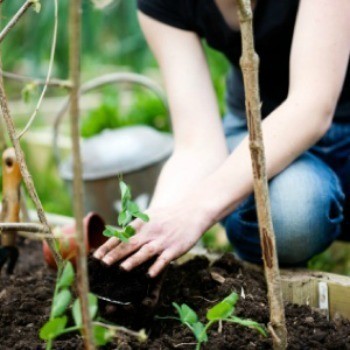
The hardening off stage in a seedling's life cycle is one of the most precarious. When the calendar says it's time to transplant, tender young plants, which until now have been spared from drying winds, cold temperatures, strong sunlight and variations in moisture, must quickly adapt to life in the garden or suffer the consequences of transplant shock. Whether you've purchased seedlings from a greenhouse or grown your own from seed, here are some tips on preparing young plants for living a life outdoors.
During the hardening off process, growth slows as the plants turn their attention to adapting to changing environmental conditions. During this pause in growth, the plant begins to accumulate and store the carbohydrates produced by photosynthesis. Once the plant has sufficiently adapted to its new growing conditions, it can readily tap into these stored carbohydrates and resume growing. The goal of hardening off plants is to minimize their shock to the change in conditions and shorten the delay in the resumption of growth.
Start the process of hardening off about 2 weeks before you intend to plant the seedlings outdoors. Hardening them off for periods longer than 2 weeks won't really provide any additional benefits to the plants, and in some cases may even delay the resumption of growth. That said, if the weather turns bad or you have an unexpected emergency on transplanting day don't sweat it. Just extend the process until conditions are favorable and you can get the plants into the ground.
Cold frames are a good way to transition your plants to the outdoors. Just remember to keep the cover/lid slightly ajar to ensure air circulation and avoid overheating tender plants. Gradually leave the cover open for longer periods of time. When you work up to a full day, you're ready to transplant.
For gardeners not using cold frames, water your seedlings well and set them outdoors in a partially shaded spot. Leave the seedlings out for about an hour the first day. Repeat this process daily, slowly increasing the amount of time they are exposed to the elements. Once they can be left out overnight, they are ready to be transplanted.
Cabbage, broccoli, and cauliflower transplants should not be exposed to cold temperatures for more than a few days, or the plants may begin to produce a seed stalk rather than the vegetative growth.
If tomato transplants are exposed to temperatures of 50 to 60 degrees F for more than a week they may produce misshapen fruit later in the season. Vine crops such as cucumber, muskmelon, and watermelon may also be injured if exposed to chilling temperatures of 55 degrees F or lower.

About The Author: Ellen Brown is an environmental writer and photographer and the owner of Sustainable Media, an environmental media company that specializes in helping businesses and organizations promote eco-friendly products and services.
Add your voice! Click below to comment. ThriftyFun is powered by your wisdom!
It is so hard to do, though. Sending them into the harsh world out there. The cloudy day does help, though. Avoid that bright sunlight.
I am fortunate enough to have a hugh open wrap around porch. This has good light much of the day, and the roof provides shelter from heavy rain, or too much sun.
Add your voice! Click below to comment. ThriftyFun is powered by your wisdom!